The AMD Ryzen Threadripper 3960X and 3970X Review: 24 and 32 Cores on 7nm
by Dr. Ian Cutress, Andrei Frumusanu & Gavin Bonshor on November 25, 2019 9:05 AM ESTPower Consumption
One of our key conclusions from our Ryzen 9 3950X review is that AMD’s TDP number on the box was now somewhat a blurred line, with the processor instead taking the ‘Package Power Tracking’ or PPT value as its true peak power consumption. This meant that for a processor to have 105 W TDP on the box, the default PPT of 142 W meant that we saw power consumption around 142 W rather than 105 W. One concern going into this review is that AMD would take a similar line with the Zen 2-based Threadripper parts as well.
Both of the TR 3960X and TR 3970X processors have a list box TDP of 280 W, which is a new ‘record’ for high power consumption in a consumer CPU. In the enterprise space we see some specialist processors break the 400W mark, but those CPUs exist in environments with a variety of cooling methods and sound isn’t much of a concern. Conversely, these AMD processors will have to live in a box under someone’s desk, so there has to be a point where the TDP is too much. Last AMD generation was 250W, this one is 280W: if we’re not there already, then this should be a practical limit. AMD of course recommends liquid cooling with a good pump and a big radiator, so anyone buying one of these processors should look into spending at least another $120+ on a good liquid cooling system.
For our power consumption metrics, we performed our usual testing: using an affinity mask to limit the cores in use, implement a high-powered workload, and then measure the power readings 30 seconds in. We take the power readings from the processor itself, using the internal registers that are designed to regulate how much the processor does a form of turbo but also regulate temperatures and so forth. This method is broadly accurate, assuming the motherboard supports the external reporting of these values, but depending on the processor family it also gives us insights into how much power is being derived from the cores individually and the package as a whole.
Here’s what we get for the 24-core 3960X:
When a single core is active, it consumes ~13.5 watts. This slowly goes down when more cores get loaded, but at 6 cores loaded we are still consuming ~12 watts per core. Even at 16 cores loaded, we’re still around 10 watts per core. This is pretty impressive. At full core loading, we’re fluctuating between 6 and 11 watts per core, as workloads get moved around to manage core loading.
From the peak power perspective, we hit 280 W with 22 cores loaded. It drops off a bit after that, like we saw with the Ryzen 9 3950X, but not by much at this time. It should be noted that as we reach these higher values, out of those 280 W, around 205 W is being used by the cores, while 75 W or so is for everything else: that means memory controllers, PCIe root complexes, and the infinity fabric. This 75 W value doesn’t vary that much, starting at 68 W even at single core load. This indicates that either IF doesn’t take much power as more cores are used, or it is on all the time.
Moving to the 3970X, and we see a similar picture:
With more cores, the power is spread around a lot more. One core loaded tops out at 13 watts, and at 11 cores loaded we can still manage above 10 watts per core. When fully loaded, we move down to as low as 3 W per core, but it does average out to around 6 watts per core. Checking the frequency at this loading and despite the 3.7 GHz base frequency, we actually have all the cores at 4.0 GHz. 32 cores at 4.0 GHz? Yes please.
The peak power metrics rise to just over 280 W when we hit 23 cores loaded and stay there, with no dip after hitting the peak. It would seem that the 3970X appears better built in that regard.
If we comment on the power between the cores and everything else, we again get a 205-210 W value for the power in the cores. This leaves 75 W or so for the rest of the chip, almost identical to the 3960X, and again this doesn’t waver much from 1 core loaded to all-cores loaded.
What will be interesting to see will be when we get the 3990X in to test as comparison. I expect that 75W value to go up – even if it goes to 100W, that leaves 180W for 64 cores, or around 3 W per core. Based on my estimates, we could be looking at anywhere from 3.0-3.5 GHz per core, which actually fits in nicely with the frequencies of the EPYC 7H12 which is also a 64-core 280W part, but for the high performance compute market.
When comparing peak power consumption to all the other CPUs in our review, as expected our new CPUs are near the top of the charts.
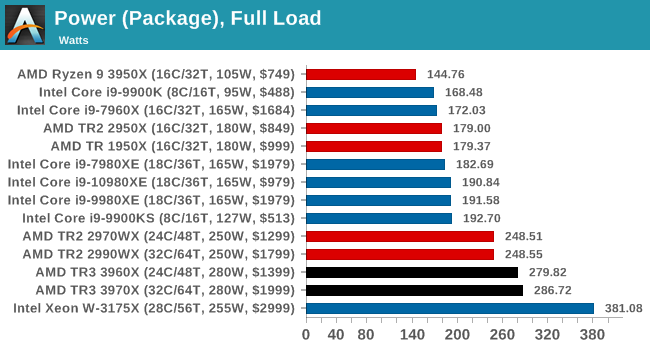
Only the unlocked 28-core from Intel peaks at a higher power, but funnily enough, that should only have a 255W TDP. So for four more cores, AMD’s peak power is still 100W below Intel’s. That’s the ‘power’ of the 7nm process node and some good quality chiplets.


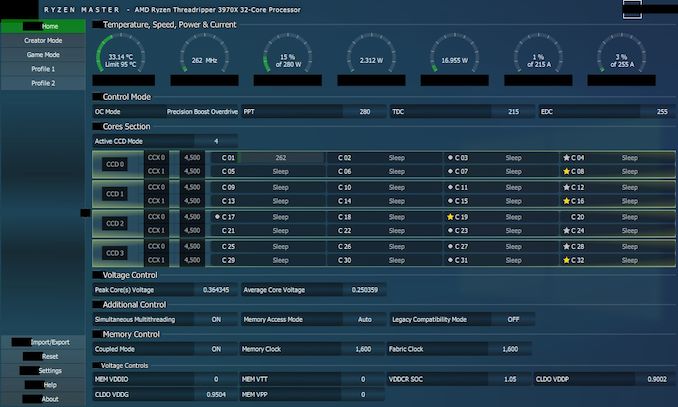
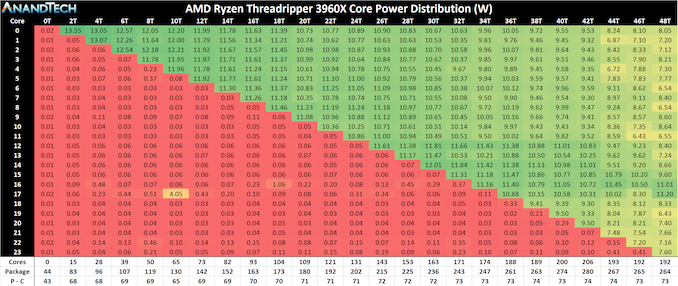
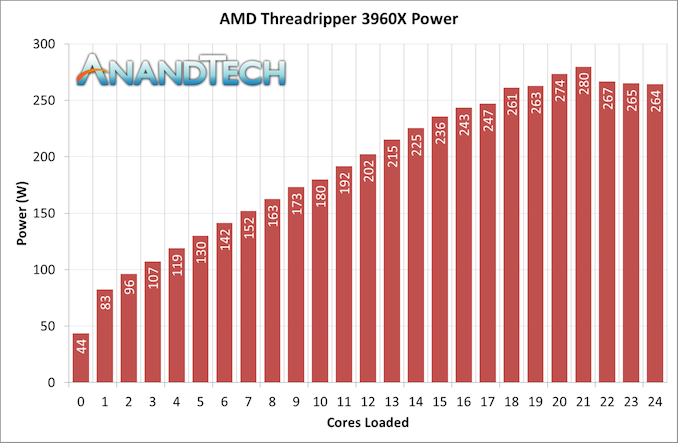
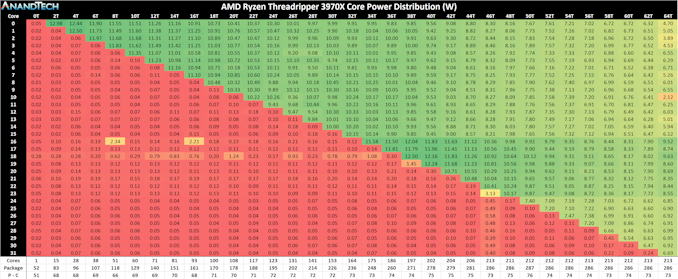
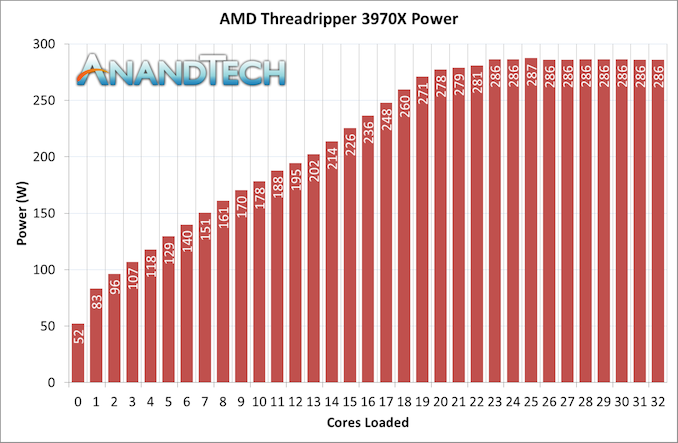








245 Comments
View All Comments
Silma - Monday, November 25, 2019 - link
Not.Congrats to AMD on great processors, but the consumer market for $1,4-$2k processors is super tiny.
Despite the current generation of AMD processors for desktops being arguably superior to those of Intel, in the financials, Intel still destroys AMD and it is indeed a bloodbath.
In my opinion, AMD would hurt Intel much more, and in the end earn more money, if it priced its offerings lower, for consumer processors as well as datacenter processors.
sgeocla - Monday, November 25, 2019 - link
Not that small.>> Workstations are a growing market segment and have been for quite some time. They run 24-7, are extremely reliable, and have features and specifications you can’t find in a PC. Therefore, workstations can command high price points because of the high expectations users have for them. Our research shows the market size for workstations is approximately 5.3 million units, about 2% of the total PC market, and brings in over $10 billion dollars a year, almost 2.5% of the PC market total, which indicates the average selling price (ASP) is higher than the ASP of a PC.
https://gfxspeak.com/2019/05/13/stands-for-worksta...
melgross - Monday, November 25, 2019 - link
Very small. The more cores, the smaller the market. What are so many cores good for? Video editing, huge databases. Financial transactions, which the chips are not likely to be used for.For most everyone else, 8 cores is still the sweet spot.
ShowsOn - Monday, November 25, 2019 - link
The review literally discusses this point:"...Intel has reported that the workstation market has a potential $10B a year addressable market, so it is still worth pursuing. While I have no direct quotes or data, I remember being told for several generations that Intel’s best-selling HEDT processors were always the highest core count, highest performance parts that money could buy. These users wanted off-the-shelf hardware, and were willing to pay for it – they just weren’t willing to pay for enterprise features...Now that we can get better performance at $1999 with 32 cores, assuming AMD can keep stock of the hardware, it stands to reason that this market will pick up interest again."
twtech - Monday, November 25, 2019 - link
They need to partner with a workstation vendor such as Dell, HP, etc. - or pick/create a company to partner with. Big businesses like to have a reliable single vendor they can deal with for all their server and workstation hardware, including support.eek2121 - Monday, November 25, 2019 - link
They really need Dell.xrror - Tuesday, November 26, 2019 - link
Sadly Dell always seems anti-AMD - or I guess more accurately they absolutely will not do anything that could jeopardize receiving Intel's contrarevenue.eek2121 - Monday, November 25, 2019 - link
Pretty much anybody that does graphics, video, etc. has a need for these CPUs. A large portion of professional Youtubers use blender or similar applications (that scale perfectly) to render things like 3d animations and the like. On the contrary. The market for these types of CPUs is larger than the gaming market. AMD's biggest obstacle here is getting prebuilt OEM systems built with sufficient cooling. Not many folks in that audience are going to build their own PC.melgross - Monday, November 25, 2019 - link
Nope. Graphics apps don’t use all these cores. I run that stuff. Neither do apps like Photoshop. If sometimes they use most cores, the usage ore core I’d down around 20% in spurts. Fewer cores simply have higher per core usage.As I said, video rendering is about the only thing that most users will find using a lot of cores. Even multasking doesn’t use 16 or more cores efficiently.
It’s also interesting that years ago, the argument was too much power. 150 Watters was considered to be on the high side, and not in a good way. Now these cores are moving to 300 watts, and nobody is saying anything.
Jimbo Jones - Tuesday, November 26, 2019 - link
Video rendering3D rendering
3D animation where physics calculation is need (cloth, particles, etc)
Particle simulations for 3D animation / work / science
Game creation / compiling / baking
Progamming (compiling)
VFX -- after effects, etc
Gaming while rendering out any of the above at the same time
Doing more than one thing at a time (Intel users close all their apps to game, lol)
Gaming while streaming
Youtube content creation (requires video rendering and encoding)
Digital audio workstations
To name a couple ...
I actually read someone on another comment feed defending Intel by saying "CPU's aren't even important these days anyway!" -- the desperation of fanbois to grasp at straws to defend the indefensible is hilarious ... right Mel?